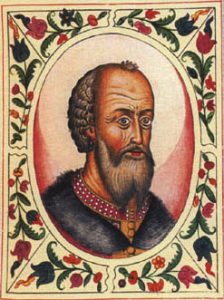(1380 – 1425)

The son of Dmitry Donskoy, Vasily I Dmitrievich, continued to gather the Russian land.
Three years later Vasily traveled to the Horde and bought from Tokhtamish Khan a label for the principality of Nizhny Novgorod and Murom.
Basil I also fought against Novgorod, as the Novgorodians sought to destroy the church’s dependence on the Moscow metropolitan and did not want to pay duties to the Grand Duke of Moscow. In this struggle, Moscow remained the winner.
Under Basil I, Rus experienced two Tatar invasions. The first was made by the Mongol conqueror Tamerlane, who appointed Khan of the Golden Horde Tokhtamysh.
When Tokhtamysh rebelled against Tamerlane, he went to war with him, won and went to the Russian land in 1395. But suddenly he returned from Yelets.
The legend that Tamerlane left Russian borders on the day when Moscow residents met the icon of the Vladimir Mother of God, which Vasily I ordered to be transferred from Vladimir to Moscow, is preserved.
The icon of Vladimir’s Mother of God remained in Moscow, in the Assumption Cathedral, and is the main shrine of Moscow.
Another invasion occurred on the following occasion. Basil I thought to take advantage of the troubles in the Golden Horde and stopped paying tribute. But the senior Murza Edigey, who was in the Horde, took a surprise attack on the Moscow region, devastated it and took from Moscow 3000 rubles for a retreat.
The Grand Duke humbled himself.
In addition, Eastern Russia, on the part of Vitovt, a Lithuanian-Russian prince, who conquered Smolensk’s destiny and wanted to subdue Moscow and himself, also suffered great danger, despite the fact that Basil I was married to his daughter.
However, it did not come to a decisive battle, and the rivals concluded a peace in which the Ugra river was designated the border between Lithuanian and Moscow Rus.